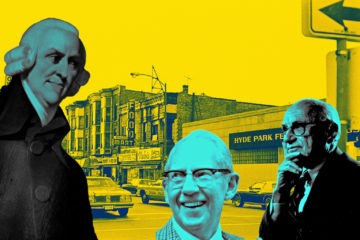 Jonathan Levy in Boston Review:
Jonathan Levy in Boston Review:
One puzzle in the intellectual history of the twentieth century is why the University of Chicago became the leading bastion of free market economics.
Scholars have proposed compelling explanations, from the strong rooting of “price theory” at Chicago by the end of the 1930s to the participation of many of its faculty members in postwar, pro-market advocacy groups that began to embrace neoliberalism by the 1960s. But having spent most of my adult life at the university and in its surrounding neighborhood of Hyde Park, I can’t help but wonder about a more quotidian contributing factor: the area’s limited range of commerce in the days when Milton Friedman, Friedrich Hayek, and George Stigler walked these streets.
Hyde Park is on Chicago’s South Side, not the posh North. The area once buzzed with urban commercial traffic—right after World War II, when many Black people moved to the city from the South in order to work in factories. Famous jazz and blues clubs abounded on the neighborhood’s central commercial corridor of 55th street, where legends like Coleman Hawkins, Art Blakey, Thelonious Monk, and Sonny Rollins played. But then the factories began to shutdown. Poverty and street crime rose. The U.S. “urban crisis” fell on Chicago.
At the university, fears arose about white flight and a potential diminished ability to recruit students and faculty. Thus began a decades-long “urban renewal” project in Hyde Park, carried out by the city and the university.
More here.
